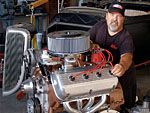
Last month, we began the buildup of what is certainly the most overlooked of all the Chrysler Hemis-a 331 with the extended bellhousing. Made from '51-53, these engines have been pretty much ignored, which means they are usually cheap as far as Hemis go. The larger 354 and 392 certainly have more performance potential-and the long-block extension can be an issue when adapting a contemporary automatic transmission-but we're building a driver, so the smaller displacement isn't an issue. The extended bellhousing actually works great with a simple flat adapter that will allow us to bolt up the four-speed transmission we want to use, and we got the engine for next to nothing-this was the Hemi for us.
Last month, we followed along as John Beck at Pro Machine assembled the short-block. This time around, we're going to look at the finishing details and some of the special features of these engines.
Rockers/Pushrods
Chryslers used a variety of pushrod lengths in Hemis
'51-53 intake 8.4375-inch / exhaust 9.906-inch
'54-56 intake 9.625-inch / exhaust 11.125-inch
'55-56 300 intake 9.775-inch / exhaust 11.240-inch
'57-58 intake 10.125-inch / exhaust 11.600-inch
'57-58 300 intake 10.240-inch / exhaust 11.740-inch
The use of later Mopar hydraulic lifters is one of the parts substitutions that is often made in early Hemis. While the diameter is correct, they are .085-inch longer and the pushrod cups accept 5/16-inch tips rather than the stock 1/4-inch, all of which means custom-length pushrods are required. But, in general, adjustable pushrods are a good idea if adjustable rockers aren't used. Decked blocks, milled heads, and reground cams can all impact rocker-arm geometry, and adjustable pushrods can compensate for them.
Diameter is another consideration in addition to length when substituting pushrods. Larger-than-stock-diameter pushrods will require drilling oversize holes in the head.
There are basically three choices when it comes to rocker arms: stock non-adjustable, factory adjustable, or aftermarket adjustable rollers like those from Hot Heads. We had a good set of non-adjustables so we had them rebuilt with new shafts and bushed rockers.
Intake Manifold/Plumbing
Out of all the options available, we chose Hot Heads single four-barrel manifold and topped it off with a Barry Grant Road Demon carburetor.
As with most aftermarket manifolds, this one is the '55-and-later style, which means there is no water passage/thermostat housing in front, as it is designed for heads with outlets in the front. The answer here it to install water lines in the tapped holes that align with the water jackets between cylinders 1 and 3, and 2 and 4.
Intermediate Shaft/Ignition
Unlike many engines that use a distributor with a gear on the bottom to drive the oil pump, Chryslers use an intermediate shaft with a gear attached to drive the oil pump and the distributor. There are only three shafts for all Hemis in stock applications: one for short-deck 331/354 engines-most DeSotos and all Dodges (PN 1323369); the second is for tall-deck 392 Chryslers (PN 1732823); and the third is for '57 DeSotos (PN 1732828).
In addition to stock dimension shafts, Hot Heads has custom lengths available to allow the use of a variety of distributors, including the late-Mopar electronic style. The combination we used included a stock shaft and an MSD ready-to-run distributor.
Spark-Plug Tubes
There were three different spark-plug tubes used in Hemis and they can be found in steel or aluminum. The '51-53 steel tubes are 6 13/32 inches; the steel and aluminum tubes for '54-55 are 5 29/32 inches, and the '57-58 aluminum tubes are 6 1/8 inches. These tubes were considered consumable items and were to be used without spark-plug washers.
With stock valve covers, the spark-plug wire covers should always be used, as they served three functions: They hid the wires, kept water out of the tubes, and pushed down on the metal rings to help seal the rubber gaskets to the rocker covers to prevent oil leaks.
On this engine, we're going with Hot Heads aluminum rocker covers that use seals that fit into the spark-plug holes.
Gaskets
You probably won't find gaskets for Hemis, or most other vintage engines, at your local parts house. Our complete set, including a modern lip seal for the rear main cap, came from Best Gasket.
Fly Wheel
Chrysler must have had an engineer who spent all day long figuring out how to do things differently than everyone else. To that end, the Hemi crankshaft flanges were not tapped for capscrews, rather bolts were used. But not just any bolts, Chrysler bolts have special heads that fit into a recess cut in the flywheel. We used a steel truck flywheel that accepts an 11-inch clutch.
Starter
Hemis will be found with either six- or 12-volt starters, and they will interchange. However, the number of teeth on the ring gear will complicate things when swapping-the tooth count was 146 from 1951-56 (actually all the way back to 1933), but it was 172 for 1957 and 1958. Chrysler changed to 12-volts in 1956, and that year had a unique starter, as it's the only 12-volt starter that is compatible with a 146-tooth ring gear. At one time, that one-year starter was the only one to retrofit a six-volt engine with a 12-volt starter. However, that has changed thanks to Powermaster, which makes high-torque gear reduction starters for both diameter flywheels.
Headers
Hemi heads have either round or rectangular ports; however, the Doug's headers we used will fit either. Available either painted or coated, we chose these tight tuck-design headers for their extra-thick flanges and large tube size.
Wrapping Up
While we weren't able to dyno test this engine, similar combinations have produced from 375 to 425 hp. But, we weren't really concerned with the numbers for bragging rights, as John Beck said, "It is what it is." Our goal for this engine was to build an affordable Hemi that was reliable, would run on regular gas, and produce respectable horsepower and torque, and we're confident it will meet all our requirements.